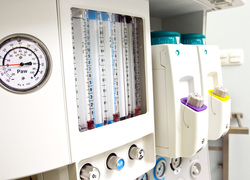
Unless you are a patient using an oxygen analyzer medical device, or an oxygen analyzer manufacturer, you might not be too familiar with these amazing devices and their diverse applications. Medically speaking, an oxygen analyzer trace collection allows for the device to detect the level of oxygen in a patient’s exhalations. This is useful information as it can help doctors and nurses to determine if the patient’s lungs are functioning correctly and at optimum levels. They are especially useful if the patient is breathing in 100% pure oxygen as a part of their current treatment plan.
If it is your first time using an oxygen analyzer, one of the most important things you can do is take good care of your device and be careful to only use it within recommended guidelines. The first thing you need to do is learn how to correctly power on and power off your device. Most machines will only need to have a power switch or button activated and deactivated as needed. These buttons and switches are often located within easy reach on the front of the device.
Next, make sure that you are able to connect the analyzer to an oxygen source such as an oxygen tank. This should not be overly difficult as most tanks come with a nozzle that connects easily with the sensor. So even if you’re not too technically inclined you should be able to get your sensor hooked up to an oxygen source with little trouble. After everything is powered on and connected properly it is time to calibrate your machine; after your unit has been active and connected for at least 30 seconds, you can hit the calibration button, often marked “CAL” or something similar. If everything is good to go an indicator will flash and read off “100%” – if this does not happen consult your device’s user manual to see if there is another indicator for your device.
There are devices made specifically for home use as well. An oxygen analyzer portable machine can be used to monitor a patient wherever they are most comfortable. The equipment is also not difficult to service, and if your machine needs to have a sensor replaced, an oxygen analyzer replacement sensor should be able to be installed by a local medical device technician.
Because of the nature of the device and its function, it is important to make sure that your oxygen analyzer natural gas settings are calibrated appropriately. Some “extra” gasses will surely become involved in the breathing process at some point as a person breathes in and out without their oxygen mask or nose tubing.
If it is your first time using an oxygen analyzer, one of the most important things you can do is take good care of your device and be careful to only use it within recommended guidelines. The first thing you need to do is learn how to correctly power on and power off your device. Most machines will only need to have a power switch or button activated and deactivated as needed. These buttons and switches are often located within easy reach on the front of the device.
Next, make sure that you are able to connect the analyzer to an oxygen source such as an oxygen tank. This should not be overly difficult as most tanks come with a nozzle that connects easily with the sensor. So even if you’re not too technically inclined you should be able to get your sensor hooked up to an oxygen source with little trouble. After everything is powered on and connected properly it is time to calibrate your machine; after your unit has been active and connected for at least 30 seconds, you can hit the calibration button, often marked “CAL” or something similar. If everything is good to go an indicator will flash and read off “100%” – if this does not happen consult your device’s user manual to see if there is another indicator for your device.
There are devices made specifically for home use as well. An oxygen analyzer portable machine can be used to monitor a patient wherever they are most comfortable. The equipment is also not difficult to service, and if your machine needs to have a sensor replaced, an oxygen analyzer replacement sensor should be able to be installed by a local medical device technician.
Because of the nature of the device and its function, it is important to make sure that your oxygen analyzer natural gas settings are calibrated appropriately. Some “extra” gasses will surely become involved in the breathing process at some point as a person breathes in and out without their oxygen mask or nose tubing.
 RSS Feed
RSS Feed